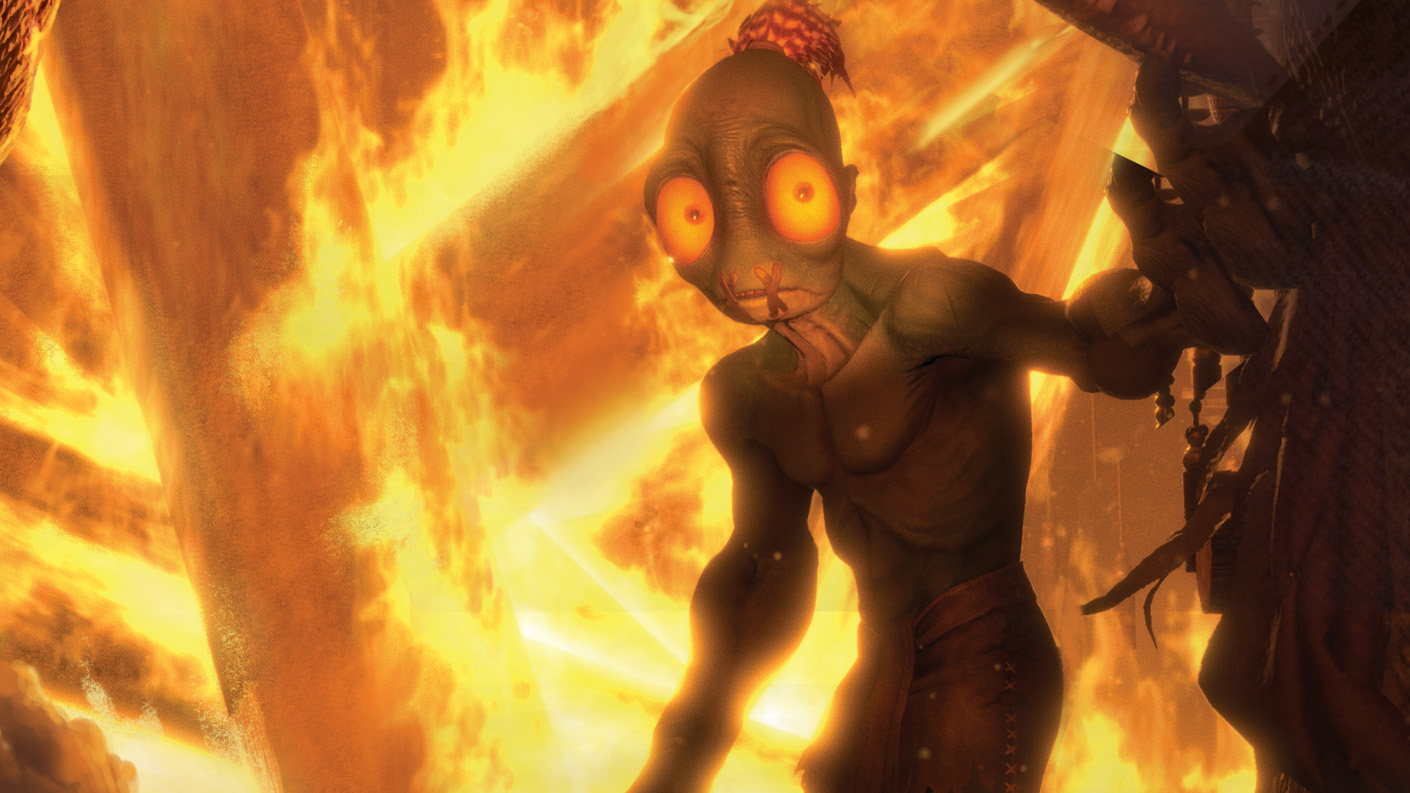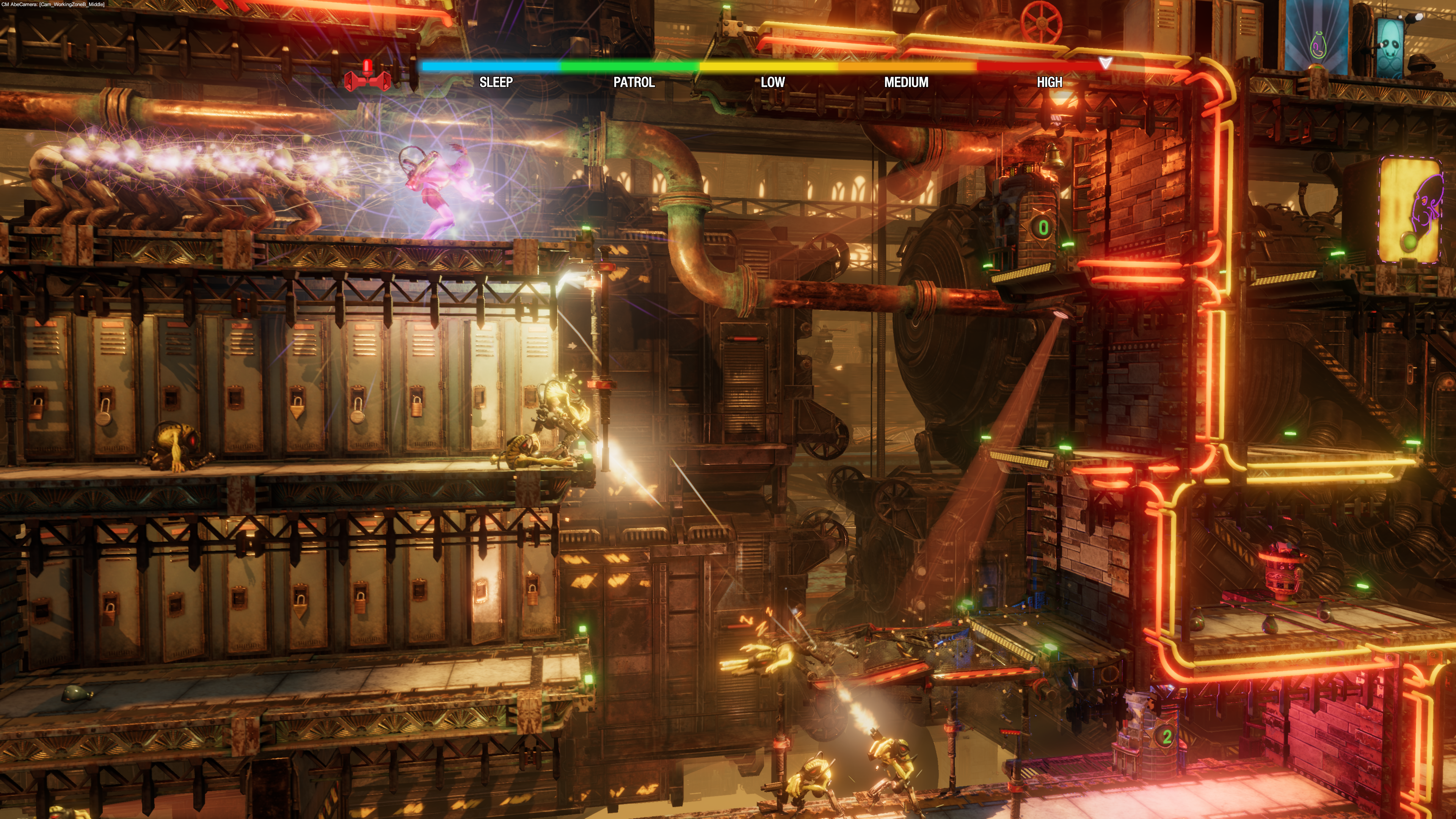Oddworld: Soulstorm is giving a classic platformer an injection of PC gaming DNA
The new Oddworld adds a deep, exciting crafting system and open-ended puzzle design to an old formula.

Lorne Lanning has been designing Oddworld games for 25 years, but he's never made one like this before. At first Oddworld: Soulstorm looks a lot like 2014's Oddworld: New 'n' Tasty. That game was a faithful remake of the first Oddworld on the Playstation, and it played like it: a 2.5D platformer with shiny new graphics, more about solving puzzles and avoiding traps than Mario-style jumping.
Soulstorm keeps that sidescroller presentation, but injects it with a dose of PC gaming DNA—think "What if Oddworld had a dash of Deus Ex?" and you're moving in the right direction.
Soulstorm is less remake, more complete redo of Abe's Exoddus
Soulstorm is less remake, more complete redo of Abe's Exoddus, the sequel Lanning and his team had to crank out in nine months back in 1998 after the success of Abe's Oddyssee. Where Oddyssee's heavy themes were based on factory farming (Abe and his mudokon pals were both workers and, it turned out, food), Soulstorm goes into "deeper shenanigans of corporate dastardliness," says Lanning. "Through Oddworld I wanted to show how our world is working."
This commentary on the evils of corporations ties into Soulstorm's re-imagining of an old platformer. There's a deep new system here built around crafting objects for puzzle-solving and combat. And these things play off each other in natural systemic ways, which can ask for and reward some pretty freeform thinking. As a simple example, Abe can toss a flammable bottle at a sleeping guard, then throw something at it to create a spark and ignite it. Toast.
Okay, molotovs are as basic videogamey as you get. But what really surprised me was when Abe needed to throw a jawbreaker through a narrow gap and around two corners to hit an enemy guard and stop them from pulling a switch that would lock down an elevator. The jawbreaker broke on impact with a wall, until Lanning jumped into the crafting menu and combined it with a rubber band. Then it could bounce—but not far enough. It would disintegrate after hitting the wall. So he combined multiple rubber bands with the ball, letting it ricochet its way to the bad guy. He also added tape to the recipe, which tied the guard up and incapacitated it on contact.
Soulstorm's evil corporate machinations will manifest in what Lanning describes as "Consumer product deviousness," but that's also the inspiration for this new crafting system. Consumer products are your weapons. "Remember Anarchist's Cookbook?" he says with a grin. "You can start making bombs out of consumer products, the things you collect, that are sold to you through vending machines. They're products sold to you by The Man that you then convert into your own stuff to use against The Man."
From what I saw of the crafting system, it's largely built on creativity and experimentation. You'll discover new recipes by trying out combinations, and I love that you can juice the effectiveness of the items you create by adding more of a certain component. It may not be completely realistic that more rubber bands will make your ball bounce farther, but it instantly makes sense in videogame logic. Small crafting changes can make big differences in how you approach a problem. Replace rope in the example above with nails, and you've suddenly got a much more lethal jawbreaker.
Keep up to date with the most important stories and the best deals, as picked by the PC Gamer team.
To get the resources for crafting these materials you'll be able to pickpocket sleeping guards (or grab stuff off their corpses) as you make your way through sprawling 2D factories and train yards. Abe's goal in this game, continuing from the story in Oddyssee, is to save mudokons from slave labor in other parts of Oddworld, as the tale of his big jailbreak from Rupture Farms spreads.
Soulstorm is a great-looking game that makes better use of 3D graphics on a 2D plane than anything I've played before. Lanning calls it "2.9D," which sounds like a good marketing soundbite but is actually a nice description of just how much deeper this game is than New 'n' Tasty. The factory level he showed me was sprawling, with layers of activity visible in the distance, playing in real time. I could see guards and mudokons walking around back there, and much of the level was off the critical path and entirely optional. Finding out how to access those areas will take a lot of exploration, which should make all the levels feel more like real, complex spaces and less like environments you simply traverse left-to-right.
"We had the most people asking for [more of] the older-style 2.5D platforming games, which really kind of surprised us," he says. "What they were telling us was that 'we like that directed experience.' It came back to this control, the simplicity of left or right, and the game being directed for them rather than them feeling like they're the director in a game. Huh, that's interesting. Not what we expected. How do we then expand on that?"
The item system stemmed from that question, though it sticks to the goal of the presenting Abe as a simple guy who has to make the most of his environment. As in the original, you'll be rescuing lots of mudokons who will follow you, and can give them basic orders while solving puzzles or keeping them out of harm's way. You'll also be able to arm them to fight back, and there will be paths through the game for rescuing every single mudokon or killing everyone, which seems pretty bleak even for Oddworld.

Lanning says Soulstorm will be about half-and-half industrial and natural settings, and described the level I saw as "medium-sized." Most of the game will be linear, but eventually you'll reach a giant train hub, at which point you'll be able to choose from five locations to guide Abe in any order. And they're all much bigger than the one I saw.
"You need to return from each with a train car, using this big train equipment," he says. "It's all laid out, but not with all the NPCs and minutiae of play [yet]. It was the best way we could find to actually map a game without mapping it so detailed that you're changing everything later once you find your real sweet spots of how it plays."
Soulstorm's not finished, and a team of about 30 developers spread across the world are working to get it done by early 2020. They've already been at it for three years. So far it's been entirely funded by the digital sales of the past Oddworld games, which Lanning is obviously proud of. Fans are also the reason this game's being made instead of wherever else Oddworld might take him.
Soulstorm is a rare do-over, a chance to get back to the story Lanning wanted to tell more than 20 years ago.
"New n Tasty ultimately moved about 3.5 million units on digital, with no advertising. We were staggeringly surprised," he says. "It showed there was a lot of goodwill out there for Abe. We asked: what should we do next? What fans really wanted us to do was remake Abe's Exoddus. And we were like, 'Fuck. Abe's Exoddus was not the game it was supposed to be! It was the game that had to be done in 9 months. That was the compromise game. I saw a meme that said 'twice the game, half the heart.' I was like, 'That's perfect! It really was.' The team did a great job, no fault of anybody, but that's what happens when you rush to get something done."
Soulstorm is a rare do-over, a chance to get back to the story Lanning wanted to tell more than 20 years ago. He brings up the "Oddworld Quintology," a plan to span that story across five games that was immediately derailed by Exoddus's rushed development. Thinking about New 'n' Tasty, Munch's Oddysee and Stranger's Wrath, I ask if Soulstorm would be the fourth. He laughs and said no: This is the second. "We're going to have to hurry up before I die," he cracks.
Soulstorm's too far away from release to say whether its new systemic elements will add as much depth as they hinted at in the half hour or so I watched Lanning play. But from what I've seen it's classic Oddworld platforming, mixed with an exciting degree of moment-to-moment decision-making. I love games that put problems in front of me and hand me the tools to solve them as creatively as possible. Puzzle-platformers are typically games about walking to the right and figuring out the solution to a challenge.
Soulstorm looks like it's going to be much more about picking the solution I find the cleverest, or funniest, or sneakiest, and that's refreshing—especially coming from the remake of a 20-year-old game.

Wes has been covering games and hardware for more than 10 years, first at tech sites like The Wirecutter and Tested before joining the PC Gamer team in 2014. Wes plays a little bit of everything, but he'll always jump at the chance to cover emulation and Japanese games.
When he's not obsessively optimizing and re-optimizing a tangle of conveyor belts in Satisfactory (it's really becoming a problem), he's probably playing a 20-year-old Final Fantasy or some opaque ASCII roguelike. With a focus on writing and editing features, he seeks out personal stories and in-depth histories from the corners of PC gaming and its niche communities. 50% pizza by volume (deep dish, to be specific).

